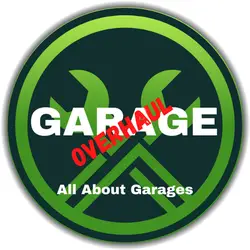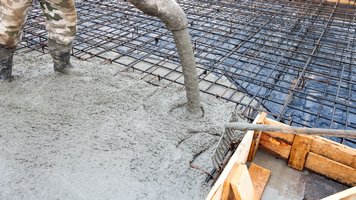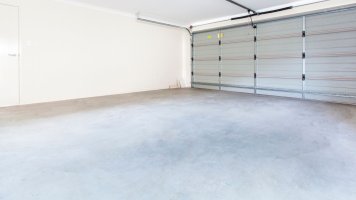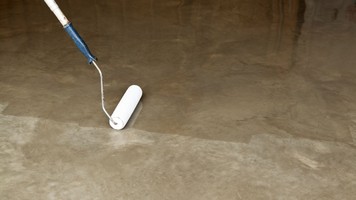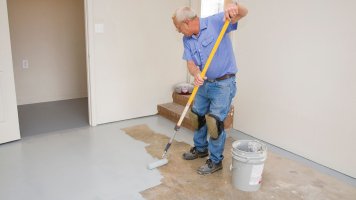How to Prevent Garage From Flooding & Installing Drains
This post contains affiliate links.
Garages can have flooding and water damage for many reasons. Maybe the garage is missing a drain, or something like gutters or driveway was built wrong during construction. Avoiding water damage is essential, so your belongings don’t suffer. Nobody wants to see ruined items. You avoid many building-related costly problems and possible mold in the long run when you keep the water out and the garage inside dry.
Installing a floor drain, New weather sealing on the garage door, fixing the roof, walls, and gutters. Installing French drainage along the driveway and taking preventive measures during storms are the general ways to prevent the garage from flooding.
In this article, we look at how to remedy the situation if your garage has constant water and flooding problems.
Common Causes of Garage Flooding
Sewage Flooding
Sewage drainage pipes can clog from dirt or too much water in the system, and leaks can happen underneath and seep into the garage.
Read why the garage smells here.
Burst Water Pipes
Freshwater pipes can burst from pressure or freezing and can leak into your garage from the ground below or if the lines go thru the garage walls.
Weather-Related
Storms, hurricanes, and heavy rainfalls cause flooding and overflowing water. Most water systems just can’t handle that much water in a short time frame.
No Floor Drains and Broken Weather-Sealing in the Garage
Some garages don’t have any floor drains, and if water gets in, it will be a problem. Retrofitting the concrete slab with a trench drain or bell trap drain is a good idea if your garage regularly floods with water. Or the floor is regularly wet and needs to be dried.
The drains will save you a lot of time and trouble. The garage floor drain is also helpful if you wash things inside the garage. With drains cleaning the floor becomes easy.
The garage door has a weather seal at the bottom and around the door(paid link). It keeps the rainwater and bugs out. Check the seal regularly and replace broken sections or get an expert to fix it. The bottom seal especially wears out and needs to be changed periodically. Changing the seals is cheap.
Read all about garage doors here.
Seal Garage Water Entry Points
Roof and Walls
Check the walls and roof for cracks and holes or get an expert to assess the situation. If your roof is leaky, it’s better to get it fixed or replaced to avoid significant water damage to the whole house. A waterproof veneer can be added to the garage walls to add water resistance to existing walls.
Read how to finish garage walls here.
Garage Door and Floor Seals
Garage doors have weather seals that deteriorate over time in the bottom of the door and around the door. These should be replaced from time to time to keep the door at least rainwater tight. A broken weather seal at the bottom of the door is most of the time the problem when your garage has water all over the floor after heavy rain.
Replacing the weather seal is cheap and fast, and even an expert installation doesn’t cost many bucks. So make sure this is the first place you check and fix.
The garage foundation should also be inspected for cracks and damage that could cause freshwater lines or sewage pipes to burst.
Garage Gutters
Check and clean the gutters yearly and make sure the builder has not cut corners with the size of gutters and you have a large enough gutter above the garage door. During heavy rain, look that the gutters don’t overflow and the water is directed long enough distance away with the downspouts from the garage door and your house foundation.
Garage Driveway
Check your driveway that it slopes away from the garage door and that the perimeter soil around the driveway is not higher than the actual driveway. The rainwater should drain off the cement and not build ponds. If needed, alter the landscape to direct the rainwater away naturally and drive the water away from the house’s foundation and the driveway.
Install a Garage Floor Drain
Building Codes and Regulations
You don’t have to be a contractor to install drains yourself, but it takes a DIY attitude and a little bit of know-how. You can rent the equipment needed.
Before starting your project, make sure you have all the permissions if required in your area. In most areas, you have to meet the local building and construction codes. There are also inspection requirements.
Some municipalities require special oil filtration or catch basins to filter the drainage pipe’s water to separate contaminants. The building code inspector may also check the drainage pipe for the proper pitch before pouring the concrete.
Check Existing Utility Lines
Before starting your project, check the location of existing water or other utility lines in the concrete slab and on your property. Contact the local authorities and check your house construction plans. When you know where the utility lines are. Planning the project can start.
- In the United States and Canada, simply call 811. The utility company will come and mark the locations of existing underground lines.
- You are legally and financially responsible for any damages if you don’t call 811 and hit and break a utility line.
Trench Drain
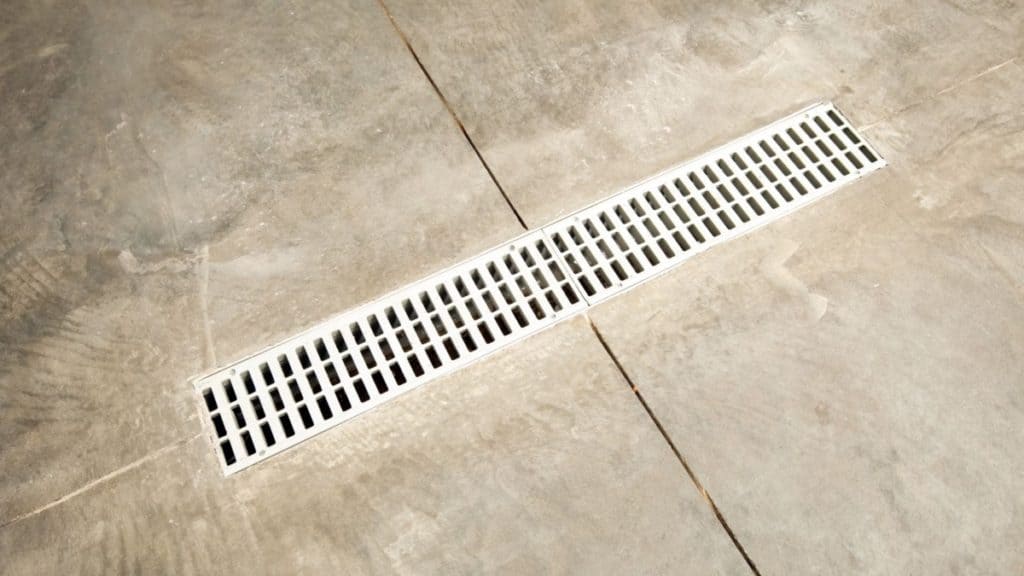
Trench drains are thin, long, and rectangular, with a removable grate on the top. Drains run into pipes and out of the garage. Trench drains come in different length sections that can be installed in the center of your garage or connected to run the entire garage length.
These are more expensive than bell trap drains, and the install time is longer, but you have easier and faster cleaning time.
Before pouring the concrete floor, you can install trench drains, which is more straightforward. Or retrofit them to the existing floor without drains. With existing floors, you have to dig the trench with heavy machinery.
Floors with a proper pitch to the drain make the cleaning faster and easier. Trench drains with built-in pitch are easier to install in both cases. The concrete floor is sloped toward the trench.
When retrofitting the drain to the floor, locating where the concrete slopes and water puddles naturally are the best place to put the drain.
Trench drains can also be installed in front of the garage along the driveway. This is a good option if the driveway slopes towards the garage door.
Check trench drains available at Amazon
Installing Trench Drain
- Rent all the tools you need, like a concrete saw and jackhammer and any other equipment required.
- Cut a trench in the slab from the drain to where it will exit the building.
- The trench should be about twice as wide as the pipe or trench and deep enough for the slope.
- Make the trench deep enough at the place where the p-trap will be.
- Dig connecting trench outside from edge of the concrete slab to where the pipe will exit to a final drainage point.
- Lay the pipe or the trench sections and keep the slope right.
- Fill the trench with self-leveling concrete and finish the concrete if necessary.
Bell Trap Drains
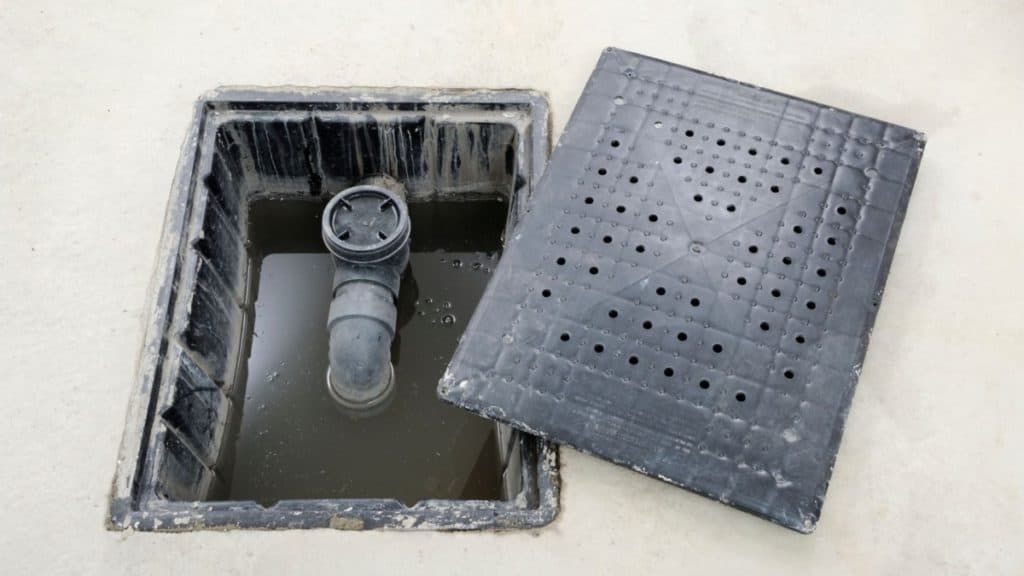
Bell trap drains are simpler than trench drains. Water runs into the drain and out through a pipe. Similar setup as your bathroom has. Bell trap drains come in a square and round variety. These are easy and fast to install. Drain sizes are usually 6, 9, and 12 inches. The drain material is usually PVC.
You can install bell trap drains before pouring the concrete floor, which is more straightforward, or retrofit them to the existing floor without drains. With existing floors, you have to dig a trench to the pipes with heavy machinery.
Floors with a proper pitch to the drain make the cleaning faster and easier. Bell trap drains are usually installed center of the garage bay and concrete sloped toward the drain from all sides. When retrofitting the drain to the floor, locating where the concrete slopes and water puddles naturally are the best place to put the drain.
Check bell trap drains available at Amazon
Installing Bell Trap Drain
Where Does a Garage Floor Drain Go?
Sometimes the drains are connected to the sewer, and other times lead to the curb and onto the storm drain. In Rural areas, the pipes can lead somewhere on the property away from the house.
Garage floor drains go to the sewer, storm drain, or onto the property away from the house. Garage floor drains must have an outlet that leads water to the discharge point. If the water is contaminated, and oil filtration or catch basin system is required.
French Drain or Trench Drain in the Garage Driveway
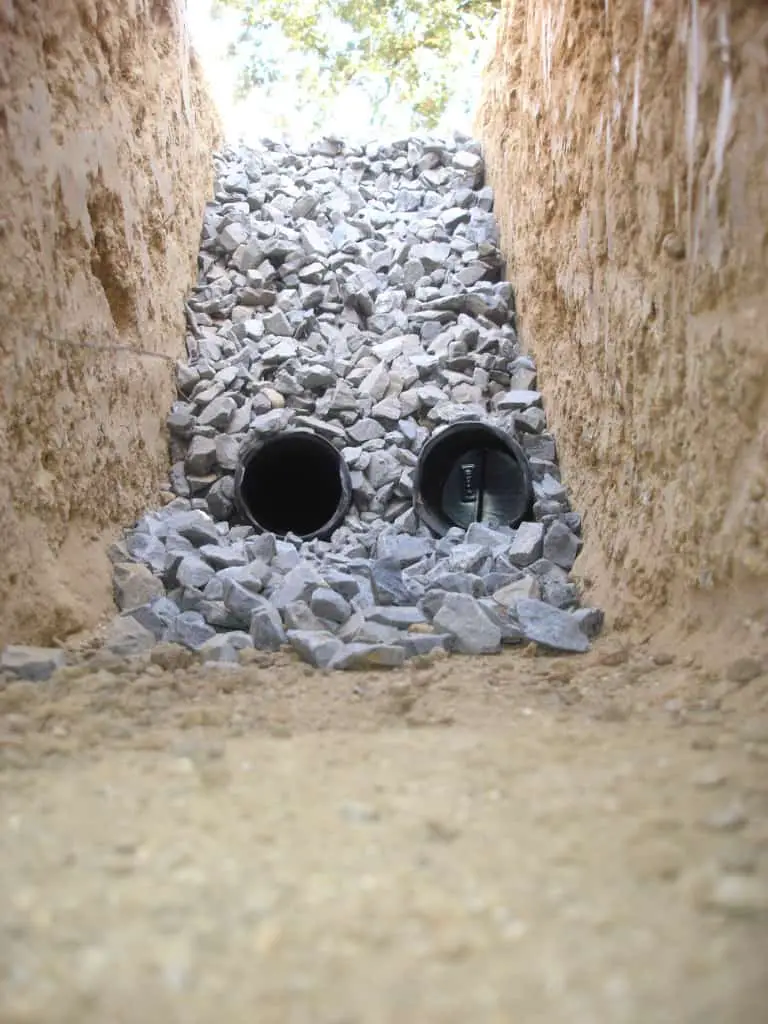
If your driveway and yard flood regularly, you could install a french drain and/or trench drain in the driveway in front of your garage. Or along the driveway to channel the water away from the garage, driveway, and house.
A French drain is a ditch in the ground inset with a perforated pipe under a layer of gravel and landscaping textile. The textile prevents soil from clogging the holes in the pipe. French drain funnels excess ground and surface water away from the foundation and driveway.
French drains are best utilized in soil that is frequently saturated from rainfall and prone to flooding.
Check landscaping drain pipes available at Amazon
Check Existing Utility Lines
Before starting your project, check the location of existing water or other utility lines in the concrete slab and on your property. Contact the local authorities and check your house construction plans. When you know where the utility lines are. Planning the project can start.
- In the United States and Canada, simply call 811. The utility company will come and mark the locations of existing underground lines.
- You are legally and financially responsible for any damages if you don’t call 811 and hit and break a utility line.
Read all about garage safety hazards here.
Installing French Drain
Read about trench drain in this section of the article.
Storm Measures for a Garage
During storms and hurricanes, it’s wise to take preventative actions to avoid water damage to your garage and household items you store. Installing barriers to direct most of the water away can save you from a lot of trouble and loss of property.
Sandbags and Flood Barriers
Rent or purchase flood barriers and sandbags(paid link) if you live in an area with hurricanes and storms and direct most of the water away from the garage and house. Use these to build temporary dams. Sandbags weigh about 30-35 pounds.
Item Storing During Flooding
- Move items that cant handle water away from the garage to the attic or house.
- Install overhead storage compartments(paid link) into the garage.
- Elevate items you cant move to the house with concrete blocks, bricks, stands, or ramps.
- Use plastic containers with lids(paid link) to airproof the items.
How Much Does It Cost to Install a Garage Floor Drain?
If you want the job done by professionals, Here is up-to-date info at Homeadvisor.com and Homeguide.com
https://www.homeadvisor.com/cost/landscape/install-drainage/
https://homeguide.com/costs/drainage-system-installation-cost
What to Do if the Garage Has Flooded
If your garage floods, take the following steps after the flood. Keep in mind your garage now may be contaminated with sewage or chemicals left over from the floodwaters. Wear protective equipment like waterproof clothing and boots, gloves, and protective eyewear(paid link).
- Turn of the power if you can access the fusebox safely. Contact expert if in doubt.
- Check the whole garage for structural damage. Take pictures for the insurance company.
- Look for cracks, sagging roof, wet insulation, and ruined wiring
- Assess the damage to your personal property, which was stored in the garage.
- Patch holes with tarps and boards if needed.
- Get the insurance company to assess the damage on-site if necessary and permission to remove any leftover water and start fixing the damage.
- Reduce moisture any way can. Circulate the air and use dehumidifiers.
- Mold and mildew start to grow after 24-48 hours after the water exposure. So wash items like clothes immediately and disinfect them and dry them.
- 10% bleach solution can be used to disinfect surfaces and remove mold.
- Salvage and clean what you can.
Read what is safe to store in the garage and what is not in here.
Read how to clean the garage here.
